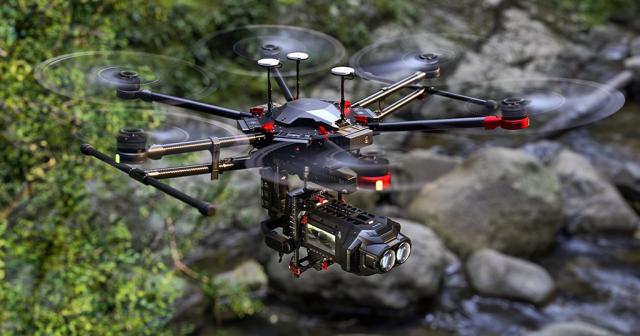Apple CEO Tim Cook opened yesterday’s WWDC 2024 keynote, during which the company unveiled numerous software updates. Apple hinted at 3D content for the Vision Pro augmented reality headset through Vision OS, but developers and fans were shown Blackmagic Design’s latest immersive cine camera, the URSA Cine Immersive.
Since the presentation, Blackmagic Design has announced the first commercial camera system that can capture Apple Immersive Video and an end-to-end workflow that incorporates DaVinci Resolve updates. A new film era is coming.


Grant Petty, CEO of Blackmagic Design, states, “We are thrilled to announce the first-ever commercial camera system and post-production software that supports Apple Immersive Video, giving professional filmmakers the tools to create remarkable stories with this powerful new format pioneered by Apple.”
In addition to its dual 8K image sensors that can record 16 stops of dynamic range, URSA Cine Immersive’s built-on URSA Cine platform boasts a fixed, unique stereoscopic 3D lens system, he explains further. Filmmakers can capture breathtaking landscapes, intimate performances, action scenes, and more with this new method. Viewers will feel immersed in the experience like never before.
Still in the works, Blackmagic has unveiled some mind-blowing camera specs that put the spectator right in the thick of things.
Blackmagic URSA Cine Immersive cameras come with a fixed dual custom lens system for Apple Vision Pro. Combining the lens and camera yields an 8160 x 7200 resolution per eye for 8K stereoscopic 3D immersive images.
Read More: Apple Vision Pro is Coming to Eight More Countries Soon
Blackmagic URSA Cine Immersive: Sci-Fi Design Meets Practicality
Blackmagic’s custom lens, meticulously designed for exceptional positional data capture, perfectly complements the large format image sensor found in URSA Cine. This innovative lens captures immersive data for each eye, which is then recorded, mapped, calibrated, and saved as a Blackmagic RAW file.
With its insect-like lens that seems like it came from a science fiction film, the new immersive camera has a fantastic style, but Blackmagic has successfully eliminated the “fi” from it. A “robust magnesium alloy chassis and lightweight carbon fiber polycarbonate composite skin” makes up the body, helping the operator maintain a steady grip while shooting without adding unnecessary weight.
On one side of the camera’s incredible body design is a 5-inch HDR touchscreen monitor, while on the other side is an exterior color status LCD. The crew can operate around the camera and eliminate the need for additional monitors thanks to a “dedicated assist station” on the opposite side of it, which has another 5-inch HDR touchscreen.
Notable features of this state-of-the-art cinematic camera include a gigantic 16 stops of dynamic range, 90 fps capture, an 8TB Blackmagic Media Module for recording, Wi-Fi, Ethernet, and mobile data network connections, and generation 5 color science with a new film curve.
While post-production and editing software has traditionally been an issue when trying to capture immersive video, that will soon change thanks to an overhaul of DaVinci Resolve, owned by industry leader Blackmagic Design.
With the upcoming update, users will have access to sophisticated new editing tools that will allow them to enhance Apple Immersive Video captured with the URSA Cine Immersive camera.
Read More: This beat-up guitar is worth $6 million. Why?
Blackmagic’s Immersive Video Viewer: Enhanced Editing for Realism
For an even more realistic editing experience, editors can rotate, tilt, and roll clips on 2D monitors or with Apple Vision Pro, according to Blackmagic’s new immersive video viewer. Bypassing Apple Vision Pro transitions with FCP XML metadata will also allow editors to work with clean master files. With the export presets, you can quickly put your images into a package that Apple Vision Pro can see.
Blackmagic is scheduling a camera and DaVinci Resolve upgrade for later this year, but they haven’t disclosed any details on pricing or delivery dates.
Despite decades of hype about immersive cinema being the future, 3D films have fallen flat and become outdated quickly. But this feels different. With technology developed by Blackmagic, Apple, and Canon, it could revolutionize video content consumption by immersing viewers in the action.
FAQs
Blackmagic’s new camera captures incredibly precise positional data for each eye, creating a truly immersive viewing experience.
Potentially. While 3D relies on glasses, this technology promises a more natural and realistic immersive experience.
Blackmagic’s immersive video viewer allows editors to manipulate footage in 3D space for a more realistic editing experience, with options for both traditional 2D monitors and Apple’s professional editing software, Vision Pro.




